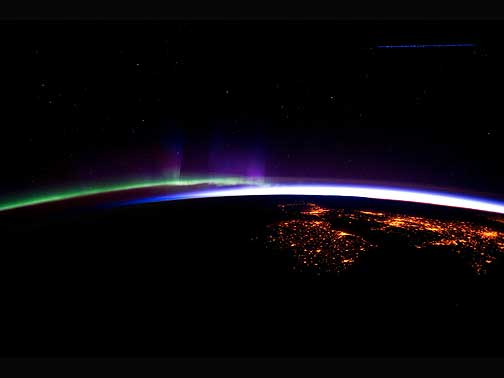
This image was taken on March 28, 2012. Image Credit: NASA
Flying at an altitude of about 240 miles over the eastern North Atlantic, the Expedition 30 crew aboard the International Space Station photographed this nighttime scene. This view looks northeastward. Center point coordinates are 46.8 degrees north latitude and 14.3 degrees west longitude.
The night lights of the cities of Ireland, in the foreground, and the United Kingdom, in the back and to the right, are contrasted by the bright sunrise in the background. The greens and purples of the Aurora Borealis are seen along the rest of the horizon.
The following information not from NASA, it is the Geophysical Institute, University of Alaska, Fairbanks, however, the site may be helpful if you have questions and looking for answers regarding auroras. More information can be found here.
Aurora is a luminous glow of the upper atmosphere which is caused by energetic particles that enter the atmosphere from above.
This definition differentiates aurora from other forms of airglow, and from sky brightness that is due to reflected or scattered sunlight. Airglow features that have "internal" energy sources are more common than aurora, for example lightening and all associated optical emissions like sprites should not be considered aurora.
On Earth, the energetic particles that make aurora come from the geospace environment, the magnetosphere. These energetic particles are mostly electrons, but protons also make aurora.
The electrons travel along magnetic field lines. The Earth's magnetic field looks like that of a dipole magnet where the field lines are coming out and going into the Earth near the poles. The auroral electrons are thus guided to the high latitude atmosphere.
As they penetrate into the upper atmosphere, the chance of colliding with an atom or molecule increases the deeper they go. Once a collision takes place, the atom or molecule takes some of the energy of the energetic particle and stores it as internal energy while the electron goes on with a reduced speed.
The process of storing energy in a molecule or atom is called "exciting" the atom. An excited atom or molecule can return to the non-excited state (ground state) by sending off a photon, i.e. by making light.

